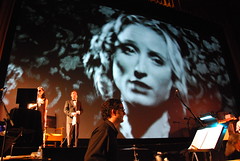I held out for just the right time to watch Guy Maddin’s Brand Upon the Brain! and caved this weekend, experiencing it like I do so many movies now, on my laptop with a couple earbud headphones. Friends, this is the absolute wrong way to experience this film. It was created as a live spectacle, to be accompanied by a narrator, 11-piece orchestra, and three foley artists. I’m embarrassed to report that I missed Brand when it played in Seattle in 2006; I can only assume I was tending to a vomiting child at the time.
Get a load of the trailer:
I was pleased to see that a passing acquaintance named Annette Toutonghi appears in the cast as one of the two murderous sisters. In another life, I sat next to Annette as we answered phones for an online retailer, calmly explaining to customers that their shipments would eventually arrive. What I remember most about Annette was her remarkable voice, a sweet trill made for narrating fairy tales. Alas! Brand Upon the Brain! is an ostensibly silent film, and Maddin had no use for Annette’s pipes.
 By ostensibly, I mean that there’s music, sound effects provided by the aforementioned foley artists, and narration in the form of an “explicator.” The DVD allows you to choose your own explicator, among them Isabella Rossellini, Crispin Glover, and John Ashbery. Jesus, people, what cinematic heaven is this?
By ostensibly, I mean that there’s music, sound effects provided by the aforementioned foley artists, and narration in the form of an “explicator.” The DVD allows you to choose your own explicator, among them Isabella Rossellini, Crispin Glover, and John Ashbery. Jesus, people, what cinematic heaven is this?
Watching the making-of feature, I began to appreciate Maddin’s mastery of cinema’s vocabulary even more. The man draws from 100+ years of film history in the form and content of his films. Flashes of color in this otherwise black and white film come inspired by similar techniques in Nosferatu. The role of explicator emerged as a result of something Buñuel said about the narrated films of his childhood. Maddin shot the film with hand-held 8mm cameras, then edited it in Final Cut Pro. While editing his previous film, Cowards Bend the Knee, he became fascinated by how the software fast-forwarded and rewinded—not more or less fluidly sped-up, as with VHS, but choppily, bypassing segments, touching down occasionally on an image. With Brand, Maddin incorporated this movement in the final product. The result is something that looks like a dream.

Pause to consider what Maddin has achieved here. It’s easy to think of him as a purveyor of images inspired by the films of the 1930s. But he is also resolutely a citizen of his own era, getting the most out of the more-or-less cheap and current technology his budgets dictate. In Maddin’s films we see a collision of both the extremely antiquated (art direction, score, melodramatic acting) and the tools and sensibilities of the YouTube generation. I would LOVE to see what he could do with a typical multi-million dollar small film budget.
This weekend I also re-watched one of Maddin’s earlier films, 1992’s Careful, recently re-released by Zeitgeist Video. Imagine a Leni Reifenstahl mountain movie as viewed through a Mark Rothko painting. The same sexual agony that makes Brand so compelling is here in spades, as Maddin and his screenwriting partner George Toles dish out a primordial tale of incest set in a town that embodies repression of the most extreme variety. The film so resolutely belongs in its own genre. Here’s a clip.
So on one hand, you’ve got Maddin’s methodology, his blend of old cinematic forms and new, of necessary cheapness and global distribution, of cinema as experienced through an 8mm lens and cinema as live spectacle. With these tools, Maddin has chosen to shape experiences most personal and shameful, each film getting closer to autobiographical purity while he embraces the freeing release of melodrama. It’s in these contradictions and forces that seemingly should be at odds, but which Maddin lovingly stitches together like a mad tailor, that his great art finds the screen.
Now I need to find the right time and place to experience My Winnipeg.




